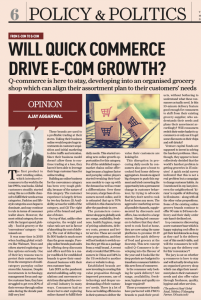The current global economic slowdown seems to be creating panic across industries, no less in retail. Like all other sectors, retailers also seem to be working on controlling operational costs.
The downturn has given them a great opportunity to enhance basket value and the shopping experience of consumers
Recruitments are frozen; organisational structure and business strategy are being reviewed and viability of low-performing stores is being scrutinised very closely. In fact, many chains have already announced that they will be closing some of their stores. It is the retailers’ fear of drastic reduction in sales numbers that is leading to this panic.
However, September and October footfalls and sales figures indicate very clearly that the economic slowdown has not affected the cash registers yet. This month, too, I have noticed that the malls are crowded.
However, I definitely expect a change in consumer buying behaviour, and every consumer will be much smarter with their wallet and will look for higher value for money. In my view, consumer traffic in modern retail is irreversible and the consumer will continue to explore destinations to extract the best value from their spend.
The financial year 2009 is expected to generate over $20 billion revenue in modern retail, and it is expected to grow to $50 billion by FY 2011. This means that modern retail is here to grow and existing players, having invested in their core infrastructure, will be looking at revised growth strategies. I certainly see this as a phase wherein some exciting opportunities have emerged for retailers.
Since the panic has been triggered by an expected drop in consumer spend, this can be a great opportunity to take another look at the business strategy with the consumer firmly at the centre this time.
Retailers will now begin to perform many important functions in new ways, such as giving importance to in-store service, and making efforts towards consumer-oriented merchandise-planning practices.
If retailers are able to develop a clear visibility of exactly what consumers expect from a particular brand, this can help them design and implement effective customer-service programmes for the store staff. They will also be able to put in place an effective system to deliver consistent and measurable service to these consumers.
During this phase, I would expect that consumers would not indulge much in impulse buying, and most of the money they spend in a store will be as per their planned shopping lists. This can be a great opportunity to enhance basket value and consumer shopping experience.
Merchandise planning systems, driven by consumer buying habits and history, will not only help retailers in achieving this but also make inventory and supply chain cycles more efficient.
Once the retailer has a deeper insight of consumer needs, it can also create new opportunities in building a broader private-label profile across the categories. This will not only lead to meeting consumer demands competitively, but also create new opportunities for increased profitability.
A key component for cutting operational costs is to have operational consistency across all store locations and gain efficiencies by streamlining processes. Ever since organised retailing started, retailers have struggled to ensure that all stores operate the same way, using the same processes and getting the same results. I don’t think any Indian retailer today is using a systematic method of getting an insight into the daily operations of each store to know which stores are complying with corporate operational practices. This operational inconsistency ultimately rubs on to many aspects of business execution — operations, merchandising, finance, human resources, loss prevention, customer satisfaction, information technology, and so on. Retailers must create a platform to
monitor process compliance of a store on an individual basis to identify areas of improvement for better results.
The downward trend in the real estate market is creating an opportunity to explore the revision of rentals of existing as well as signed-up properties. Retailers who were delaying their new store openings due to higher rental costs on committed properties are now going to renegotiate and work out new rollout plans. In case they find that some of their existing stores are unviable, they will now explore the use of the same property for another format — having first renegotiated the rental.
From a series of articles commissioned by DNA (Money) dated 27 November 2008.



